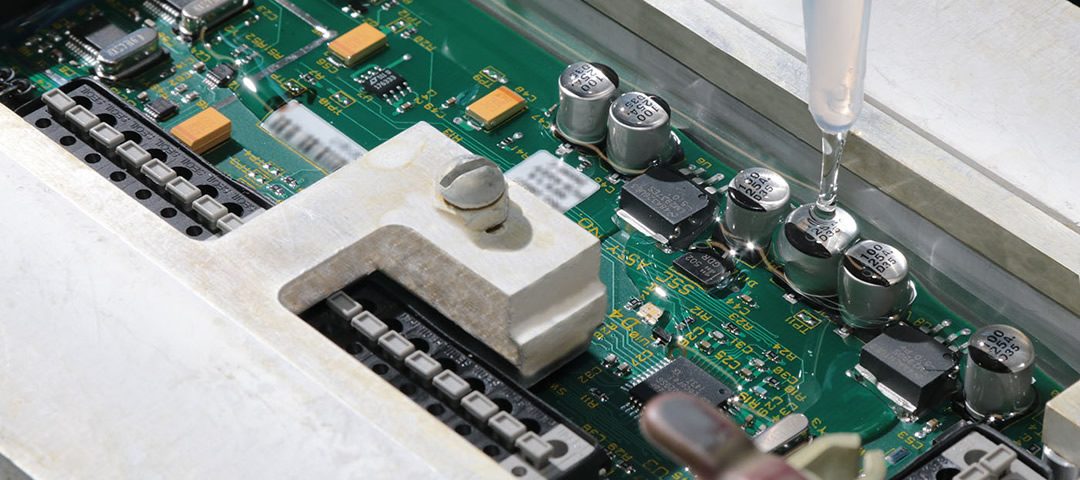Search this site
Don’t Change Your Legacy Adhesive. Modify It!

An example of a circuit board being encapsulated.
Today’s hardware and assembly companies are using and qualifying sophisticated adhesive systems for a myriad of applications: to replace traditional fasteners and hardware, to coat printed circuit boards against humidity and harsh environment, or to isolate critical components in protective housings.
These adhesives, potting compounds, and conformal coatings are expected to become a standard in certain applications because of the costs associated with qualification testing. The testing assessments often include post cure and aging tests for mechanical properties such a lap shear, chemical resistance, and out gassing, as well as economic considerations such as shelf life.
Once qualified and standardized, these systems will be used for multiple generations. But what if they don’t meet the application, coating, or filling requirements of newer generations of end products?
Does a company scrap thousands of dollars’ worth of investment in these crucial systems, only to have to re-qualify a new system? The answer is not necessarily.
Instead of qualifying a new system of adhesive or coating, changes in requirements can sometimes be addressed by the careful modification of physical properties of the current system. Thixotropy is your friend!
Initial flow and thixotropic considerations (mayonnaise, mustard or maple syrup)
While we could certainly give a definition for thixotropy, a basic analogy should suffice. At room temperature, do you want the consistency of mayonnaise (slick and thick, and will fill voids with time), mustard (thick and stays put), or maple syrup (slightly thick and readily flows until you stop it)?
Contemplating these everyday condiments can lead us to considering how to physically modify the adhesive system, without altering the basic formulation that drives its performance and qualification.
Time, temperature, and viscosity
The next question has to do with where the material needs to “Go” or “Not Go.” Many adhesive systems’ viscosity (or thickness) change with temperature, with some starting out quite thick and becoming as viscous as isopropyl alcohol just before curing.
Understanding the requirements for filling, slumping, tacking, staking, wicking or not wicking, and coating is critical. Also, the timing of such required behavior during the application and curing process must be considered.
For example, in certain integrated circuit packaging underfill applications, full coverage might be achieved only when lower viscosity is realized during a thermal cure ramp that allows sufficient spreading to ensure no porosity and excellent uniformity.
The stop and the start
Ultimately until an adhesive, potting, or conformal coating system is cured, it’s just a bunch of chemicals. Modifying the physical characteristics of an existing adhesive system can improve the capability of these desired factors.
- Accelerators such as Ultraviolet (UV) Curing can effectively stop materials from flowing, while maintaining desired geometries and starting the curing process.
- Fillers such as fumed silica can help keep materials where you want them when containment is not an option.
- The addition of non-reactive volatile compounds can modify whetting and filling characteristics, while not compromising strength.
- Adhesives can be modified to maintain critical bond line thickness with glass spheres.
Many of these tools can be used in combination. For example, many applications benefit from a UV tack step to improve cycle times by freeing up tooling, allowing a subsequent longer batch (oven) or continuous (conveyor) thermal cure to complete the process.
Cure rates, ramps, and dwells can be considered, and as well material movement through these phases.
Also, excessive application pressure and small application tips can shear materials, resulting in a material being modified by the means of application. Considering the optimized application formulation and the desired outcome is critical for high yields and predictability.
Where the magic happens: The premixed and frozen solution
After all of this effort to maximize an adhesive system’s performance, wouldn’t it be nice to stop the perfect solution in time?
Imagine being able to use it where and when you need it, applying and curing it with confidence. Most chemical reactions stop at the temperature of -60C, Appli-Tec’s storage temperature. In fact, most stop at -40C.
Appli-Tec can modify, mix, degas, and package your legacy adhesive systems, effectively stopping curing with our expertise in freezing and storage.
Breathe new life and save money on your legacy products with Appli-Tec’s expertise
Adhesives require expertise, awareness, and a willingness consider and control for unknowns. Appli-Tec has a long history of working with customers on their designed-in material systems to improve yield, consistency, performance, reliability, and to eliminate excessive waste.
Appli-Tec has the ability to take all of that complexity and aggravation and a make the adhesive a line item on a Bill of Material again, with a Certificate of Conformance and a team to stand behind it.
Where many of our customers used to worry about their adhesive mixing, processing, and application, our commitment to continuous improvement, combined with our world class process control and product traceability, can free them from this anxiety.
We Offer: Precision Adhesive Mixing, Custom Packaging and Labeling based on usage, Degassing, Freezing and Storage Options, Waste Mitigation Strategies, as well as technical and application assistance.
Ask about our Freezer Loaner Program to take away a barrier to saving money.
Modifying an existing adhesive system rather than requiring a new solution is another way Appli-Tec lives to its core value of improving our customers’ productivity and success.
New Applications
I want to discuss my application challenges, order samples, or place a first-time order.
Existing Applications
I need to reorder an existing part number, I have a BOM/Spec.


